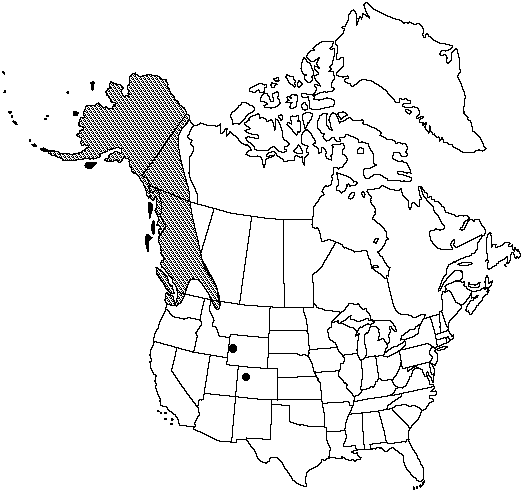Difference between revisions of "Huperzia haleakalae"
Folia Geobot. Phytotax. 20: 73. 1985.
FNA>Volume Importer |
imported>Volume Importer |
||
| (7 intermediate revisions by 2 users not shown) | |||
| Line 8: | Line 8: | ||
}} | }} | ||
|common_names=Alpine fir-moss | |common_names=Alpine fir-moss | ||
| − | |basionyms={{Treatment/ID/ | + | |basionyms={{Treatment/ID/Basionym |
|name=Lycopodium haleakalae | |name=Lycopodium haleakalae | ||
|authority=Brackenridge | |authority=Brackenridge | ||
| + | |rank=species | ||
| + | |publication_title=in Wilkes, U.S. Expl. Exped. | ||
| + | |publication_place=16: 321. 1854 | ||
}} | }} | ||
|synonyms={{Treatment/ID/Synonym | |synonyms={{Treatment/ID/Synonym | ||
|name=Lycopodium selago var. haleakalae | |name=Lycopodium selago var. haleakalae | ||
|authority=(Brackenridge) Warburg | |authority=(Brackenridge) Warburg | ||
| − | }}{{Treatment/ID/Synonym | + | |rank=variety |
| + | }} {{Treatment/ID/Synonym | ||
|name=Urostachys haleakalae | |name=Urostachys haleakalae | ||
|authority=(Brackenridge) Herter ex Nessel | |authority=(Brackenridge) Herter ex Nessel | ||
| + | |rank=species | ||
}} | }} | ||
|hierarchy=Lycopodiaceae;Huperzia;Huperzia haleakalae | |hierarchy=Lycopodiaceae;Huperzia;Huperzia haleakalae | ||
| Line 26: | Line 31: | ||
}}<!-- | }}<!-- | ||
| − | --><span class="statement" id="st- | + | --><span class="statement" id="st-undefined" data-properties=""><b>Shoots </b>erect, indeterminate, 8–11 cm, short- to long-decumbent, 3–8 cm; leaves in mature portion smaller than in juvenile portion; annual constrictions absent; juvenile growth erect. <b>Leaves</b> spreading-ascending to appressed, yellow-green to yellow-brown, greener at stem tip (top 1 cm), lustrous (as if covered with clear yellow varnish); leaves in juvenile portion lanceolate, 4.5–6(–7) mm, apex acute; leaves in mature portion ovate, 3–4 mm, apex acute; margins entire, with scattered papillae; stomates present on both surfaces, numerous (38–84 per 1/2 leaf) on adaxial surface. <b>Gemmiferous</b> branchlets produced throughout mature portion of shoot; gemmae 3–4 × 3.5 mm, lateral leaves 1.5–2 mm wide, broadly acute to obtuse. <b>Spores</b> 31–41 µm.</span><!-- |
-->{{Treatment/Body | -->{{Treatment/Body | ||
| Line 32: | Line 37: | ||
|elevation=(160–)1300–1700(–3600) m | |elevation=(160–)1300–1700(–3600) m | ||
|distribution=Alta.;B.C.;Yukon;Alaska;Colo.;Mont.;Wash.;Wyo.;Asia in Siberia;Pacific Islands (Hawaii). | |distribution=Alta.;B.C.;Yukon;Alaska;Colo.;Mont.;Wash.;Wyo.;Asia in Siberia;Pacific Islands (Hawaii). | ||
| − | |discussion=<p>Huperzia haleakalae has been found in Hawaii in Haleakala Crater, on Maui, at 2300 meters, but it is extremely rare or possibly extinct there.</p> | + | |discussion=<p><i>Huperzia haleakalae</i> has been found in Hawaii in Haleakala Crater, on Maui, at 2300 meters, but it is extremely rare or possibly extinct there.</p> |
|tables= | |tables= | ||
|references= | |references= | ||
| Line 41: | Line 46: | ||
-->{{#Taxon: | -->{{#Taxon: | ||
name=Huperzia haleakalae | name=Huperzia haleakalae | ||
| − | |||
|authority=(Brackenridge) Holub | |authority=(Brackenridge) Holub | ||
|rank=species | |rank=species | ||
| Line 55: | Line 59: | ||
|publication year=1985 | |publication year=1985 | ||
|special status= | |special status= | ||
| − | |source xml=https:// | + | |source xml=https://bitbucket.org/aafc-mbb/fna-data-curation/src/2e0870ddd59836b60bcf96646a41e87ea5a5943a/coarse_grained_fna_xml/V2/V2_462.xml |
|genus=Huperzia | |genus=Huperzia | ||
|species=Huperzia haleakalae | |species=Huperzia haleakalae | ||
| − | |||
| − | |||
| − | |||
| − | |||
| − | |||
| − | |||
| − | |||
| − | |||
| − | |||
| − | |||
| − | |||
| − | |||
| − | |||
| − | |||
| − | |||
| − | |||
| − | |||
| − | |||
| − | |||
| − | |||
| − | |||
| − | |||
| − | |||
| − | |||
| − | |||
| − | |||
| − | |||
}}<!-- | }}<!-- | ||
-->[[Category:Treatment]][[Category:Huperzia]] | -->[[Category:Treatment]][[Category:Huperzia]] | ||
Latest revision as of 20:23, 5 November 2020
Shoots erect, indeterminate, 8–11 cm, short- to long-decumbent, 3–8 cm; leaves in mature portion smaller than in juvenile portion; annual constrictions absent; juvenile growth erect. Leaves spreading-ascending to appressed, yellow-green to yellow-brown, greener at stem tip (top 1 cm), lustrous (as if covered with clear yellow varnish); leaves in juvenile portion lanceolate, 4.5–6(–7) mm, apex acute; leaves in mature portion ovate, 3–4 mm, apex acute; margins entire, with scattered papillae; stomates present on both surfaces, numerous (38–84 per 1/2 leaf) on adaxial surface. Gemmiferous branchlets produced throughout mature portion of shoot; gemmae 3–4 × 3.5 mm, lateral leaves 1.5–2 mm wide, broadly acute to obtuse. Spores 31–41 µm.
Habitat: Terrestrial in exposed, moist meadows and mossy heaths in alpine and subalpine zones
Elevation: (160–)1300–1700(–3600) m
Distribution

Alta., B.C., Yukon, Alaska, Colo., Mont., Wash., Wyo., Asia in Siberia, Pacific Islands (Hawaii).
Discussion
Huperzia haleakalae has been found in Hawaii in Haleakala Crater, on Maui, at 2300 meters, but it is extremely rare or possibly extinct there.
Selected References
None.